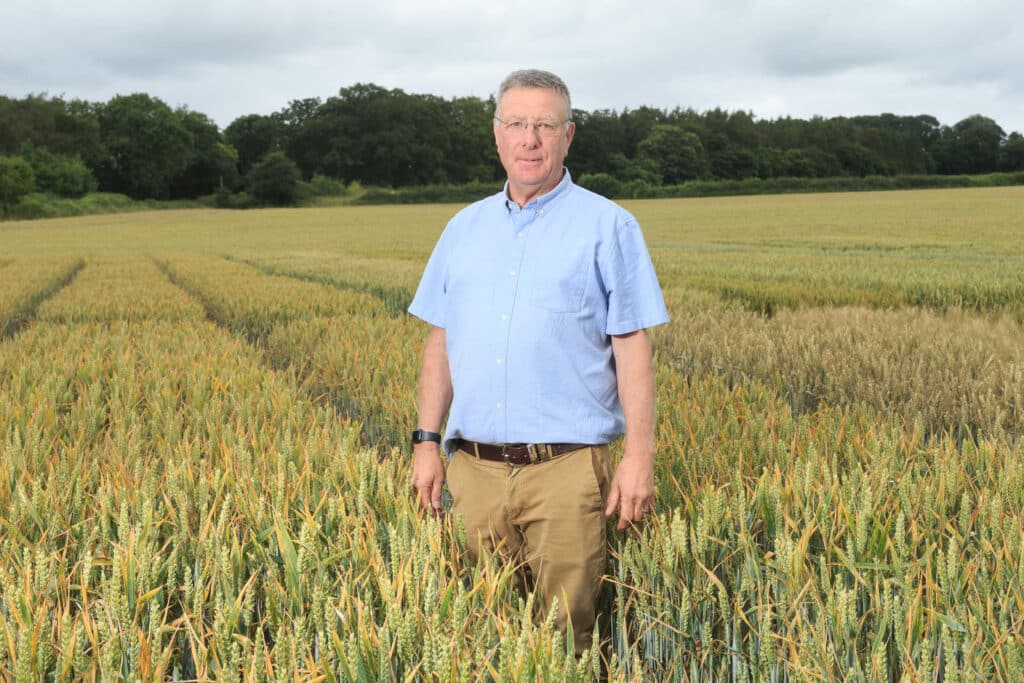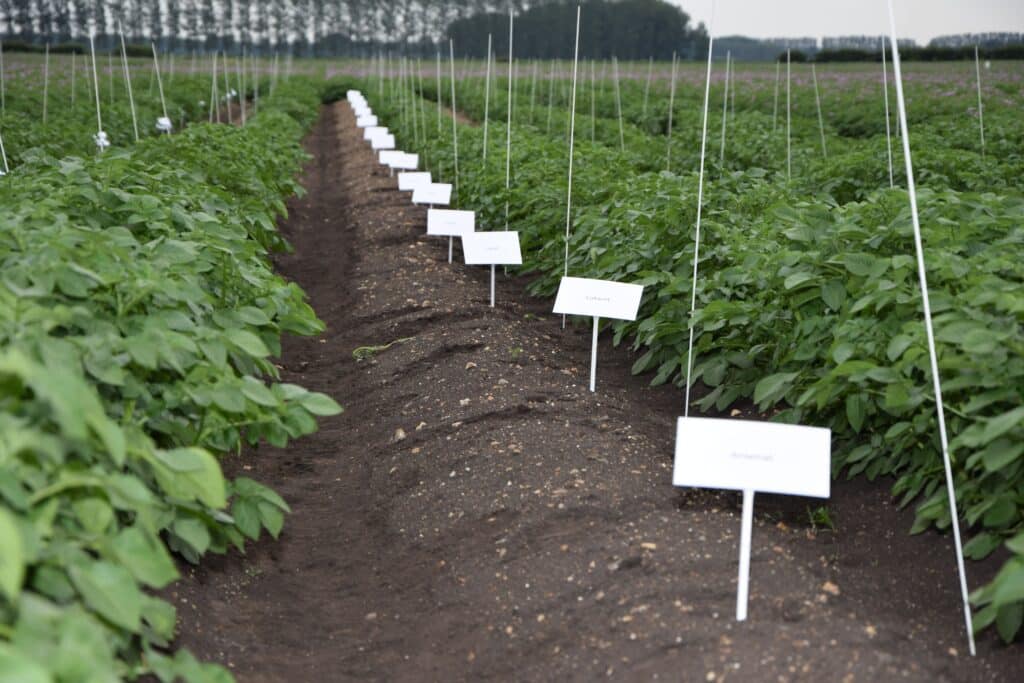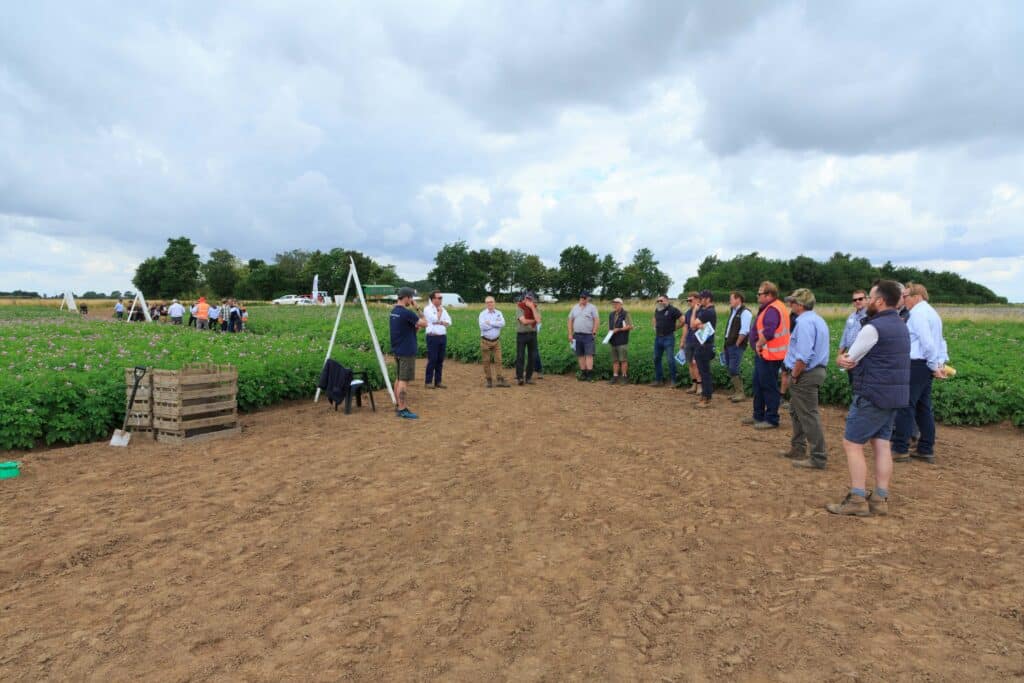Choosing your variety – British Potato Review
Andrew Goodinson offers top tips for choosing varieties, preparations for late lifting and reflects on the 2024 potato growing season so far ...
Andrew Goodinson, Agronomist, and Potato Specialist at Hutchinsons, offers advice and insights to help growers ensure the best results from their potato crops. Based in Herefordshire, Andrew has been working for Hutchinsons for 17 years and looks after 8,000 ha of farmland, including the Welsh borders, south Shropshire and Worcester. Most of the potato crops he looks after are destined for the crisping or processing markets.
When it comes to varietal choice, building dialogue and relationships with both the customer and the seed grower can make a big difference to outcomes, advises Andrew.
This can help overcome the disconnection between growing for a specific market with the agronomic and physical options available to the grower, and, in the case of pre-pack potatoes, the market which is dominated by a few varieties that supermarkets prefer.
“The range of potentially suitable varieties for the pre-pack sector is huge, but in Britain we tend to be limited to growing the same few because of their visual and culinary attributes, rather than using varieties with agronomic and environmental benefits,” Andrew said.
Therefore, work still needs to be done to continue to develop varieties with tolerance and resistance to soil-borne, and foliar pests and diseases, he advised.
“We need to look harder at genetics to find new varieties with tolerance to viruses such as Potato Leaf Roll Virus (PLRV), which is a persistent virus transmitted by aphids. We also need varieties with tolerance and resistance to pests such as potato cyst nematodes (PCN) and free-living nematodes (FLN).
“The amount of land infested with PCN and/or FLN is increasing, so varietal tolerance and resistance to this is becoming critical. This is even more important in years where crops are planted in less than ideal soil conditions leading to crops not having the root system or biomass to reduce the effect of the pests.”
He draws a comparison between old fashioned large biomass wheat varieties and current semi- dwarf wheats which have smaller roots and less biomass, making them more vulnerable to diseases such as Take-all. This is because bigger roots are better able to scavenge for nutrients, to help it reach its potential. Some processors are encouraging their growers to plant particular varieties such as French frying variety King Russet which can be planted earlier, lifted earlier, and are resistant to some strains of PCN genotype Globodera pallida compared with other varieties in the sector.
King Russet tubers also have more eyes per tuber, meaning that they can potentially be cut in half in a similar way to Shepody which increases seed efficiency.
Another of the newer varieties tipped to become popular is Elland, which has potential to be a dual purpose potato suitable for both processing and pre-pack markets.
“It looks a promising, versatile variety,” said Andrew, noting that the variety has both resistance and tolerance to G. pallida. “Other varieties are also coming forward with these characteristics, too, which will widen the growers’ choice.”
Storage remains an important aspect of the industry, and with high energy costs alongside the need to reduce the carbon footprint, long dormancy has become another important trait.
“However, until now, there have been challenges with some crisping varieties, for example Lady Claire has excellent long term. storage characteristics, but has a shorter growing season than other varieties. Newer varieties are being grown to address this. challenge, such as the likes of Titan and Cinderella, which are higher yielding but do not have the same long-term storage traits.”
There are promising new varieties in the pre-pack sector too, such as early maincrop varieties such as Manhattan and Isabelia, and others, he adds.
“New varieties are the future for our industry and some of their traits could help improve grower profitability.”
Convincing growers
Processors appear to be well aware of the agronomic challenges being faced and how growers need to address them and also the need to work towards a lower carbon footprint, he notes.
“We need more discussions between the growers, buyers and the marketers in the fresh sector. At present, packaging information on packs of potatoes is lower than for many other food products on the supermarket shelves.
“Bringing awareness of the potential advantages of other, new varieties with agronomic qualities such as disease resistance and the need to use fewer plant protection products, and therefore helping growers build better conservation practices, should be promoted at the point of sale.”
Getting the most from your seed
Andrew recommends visiting the seed supplier/ producer to view the crop in-field or in-store.
“If you build links with the seed grower, it is easier to choose the seed that meets the growers’ specifications, plus it provides an opportunity to talk about seed treatments and whether they can be applied before transport,” he said.
The sector is moving away from on- planter powder dressings, and towards liquid applications, which must be applied on a roller table unit on a grading line.
“This is a positive step because even with seed powder applicators, their use is still an imprecise science and the powder is prone to blowing across the field in the wind and can stick to equipment and operators.”
Liquid applications can be done at the seed source or on arrival at the farm, he says.
“Liquid seed treatment is a more accurate way of protecting the seed, but it needs managing. For example, the treatment needs to dry before moving the seed back into store. However, it should be noted that increased handling of the seed can result in bruising or sprouts being knocked off if due care is not taken.
“Also, some products need to be applied before chitting or to dormant tuber, so always apply before dormancy break”
Tips for Variety Choice
| • Consider the attributes and traits demanded by the end market |
| • Gross margin of the crop |
| • Assess the variety's suitability for the particular farm, altitude and aspect of the field which can impact on crop potential |
| • Assess the variety's suitability for the pest and disease profile of the land to be used |
| • Treat the variety as a critical input for maximising profit margins |
Preparing for late lifting
If conditions are wet at lifting, ventilation becomes key for drying tubers and preventing the development of rots, says Andrew.
“Airflow takes the path of least resistance, so boxes need to be properly stacked with the pallet openings aligned to the airflow, and boxes stacked to the same height to ensure the air passes through the boxes and not over or around them.”
If cooling needs to be done for ware crops, Andrew recommends ensuring the air temperature should be within 3-4 deg.C of the crop temperature, and should not be reduced by more than half a degree per day.
Temperature monitoring to avoid condensation is critical too, he adds. “This needs to be consistent throughout the store, and variations should be less than 1 deg.C”
Drying is normally more important than cooling, he notes, but where there is a risk of
black dot or silver scurf in ware, temperatures may be brought down sooner, however this depends on the individual situation.
Where curing needs to be done, the temperature should be maintained at 10 deg.C for four to five days.
Reflections on the 2024 season
Considering the long, wet, warm winter and the cool, late spring, there have been many cases of first fields being planted in less-than-ideal soil conditions.
Nevertheless, the crops grew away and although some ran out of steam where the soil had been too wet and had smeared, they still yielded better than those that were planted later, which struggled to make average yields, said Andrew.
“There was plenty of moisture and the early planted crop canopies developed reasonably well, whereas mid-planted ones suffered from insufficient light intensity and the canopies did not close across the rows.”
At the end of June, some crops were infected with aggressive late blight genotype 36_A2.
“By the end of July, it had gone from very wet to dry, with soils hardening and air temperatures of 26-27 deg.C, which dried the blight better than the fungicides, but it slowed crop development too.”
Nonetheless, with seed that was physiologically less mature than that used in
2023, plants appeared to set more tubers than last year, which increased the yield potential of crops. Varieties with the potential of higher tuber numbers are in trials this year.
“We also observed where we were applying foliar crop nutrition during early growth helped with both yield and longevity rather than fire-fighting crop deficiencies later in the season,” Andrew said.
He added that where growers placed fertiliser at planting, this worked well because the developing roots quickly obtain access to the nutrients, helping emergence and vigour. “A lot of tissue testing identified samples to be low in P, even though the nutrient was present in the soil; in many cases boron was also low. However, N levels were optimal.”
With regard to pest and disease incidence over the season, he points out that using systemic blight-control actives at the rapid canopy phase, helped keep inoculum down throughout the season.
He also reports cases of confusion between outbreaks of Botrytis and Alternaria.
“Lifting greencrop has resulted in some good yields with higher-than-normal dry matter (DM) levels. As a result, harvesting team staff have had to take great care to avoid bruising.”
Motivating staff
Bringing all the staff together to discuss the farm’s aims, and why the operate in a particular way, can help improve teamwork, says Andrew.
“It is also a good idea to ask machinery suppliers to come to the farm for half-day workshops where they talk to staff and explain how to maximise machinery efficiency.”
This can involve learning about getting the most from tractors, but other topics are of interest too, such as how spray nozzles and closed transfer systems work.
In addition, training can motivate and engage employees because it builds understanding of what they are doing and where their work fits in, he notes.
“The better informed your staff, the better equipped they are to enhance the efficiency of their work”.



